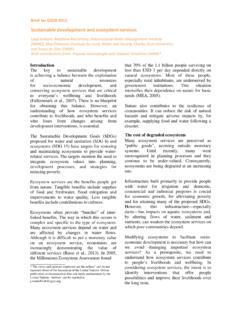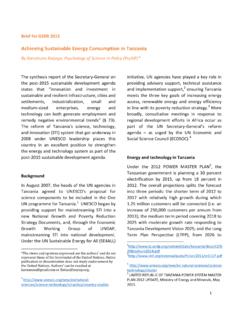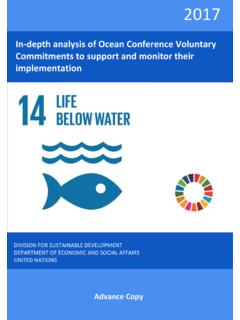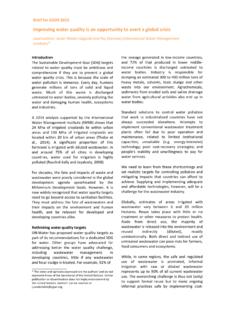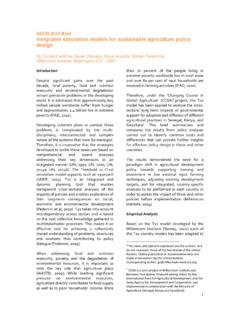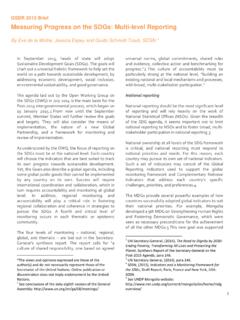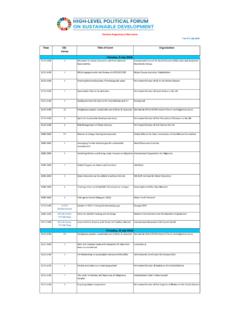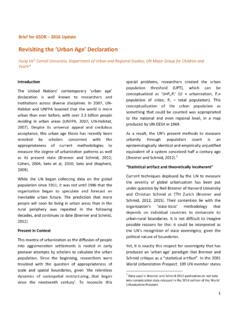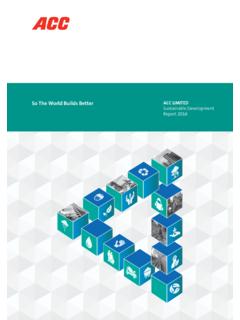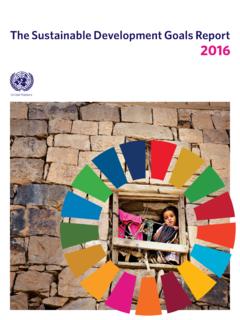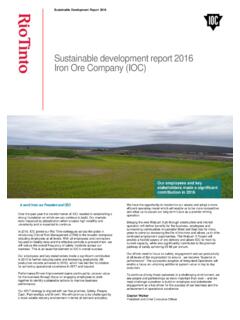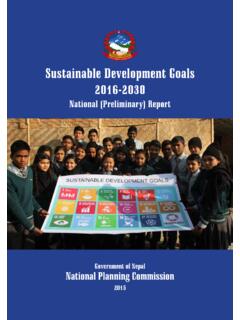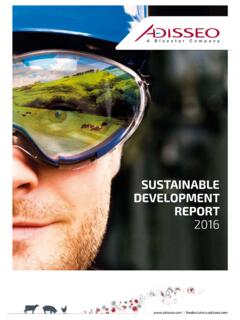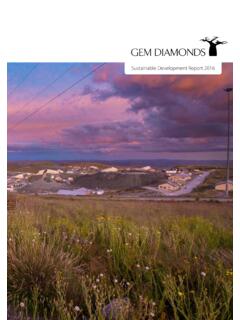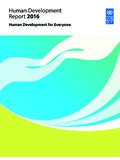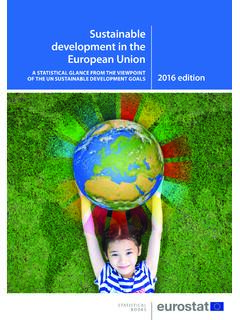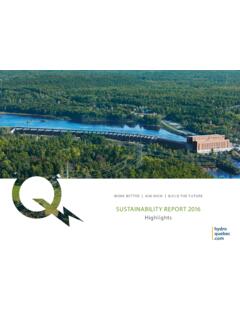Transcription of GLOBAL SUSTAINABLE DEVELOPMENT REPORT
1 GLOBAL SUSTAINABLE DEVELOPMENT REPORT2016 EDITIONS uggested citation: United Nations, 2016 , GLOBAL SUSTAINABLE DEVELOPMENT REPORT 2016 , Department of Economic and Social Affairs, New York, July. GLOBAL SUSTAINABLE DEVELOPMENT REPORT2016 EDITION CONTENTSA cknowledgements .. viExecutive summary .. xIntroduction .. 1 Chapter 1. Ensuring that no one is left behind and the 2030 Agenda .. 3 Introduction .. 3 Leaving no one behind, poverty, inclusiveness and equality .. 4 Leaving on one behind in SUSTAINABLE DEVELOPMENT Goals and targets .. 5 Who are those left behind? .. 7 Defining and identifying those left behind .. 7 Dynamic versus static measures of inequality and poverty .. 8 Reaching those left behind .. 9 Strategies for ensuring that no one is left behind .. 11 Economy-wide growth strategies .. 11 Social protection systems .. 11 Area-based strategies .. 12 Sectoral strategies .. 13 Conclusion considerations for decision-makers.
2 16 Chapter 2. The infrastructure inequality resilience nexus .. 21 Key interlinkages .. 24 Infrastructure and inequality .. 25 Infrastructure and resilience .. 27 Inequality and resilience .. 30 Harnessing synergies and addressing trade-offs .. 30 Infrastructure inequality resilience in rural areas .. 31 Infrastructure inequality resilience in urban areas .. 31 Conclusions .. 32 Chapter 3: Perspectives of scientists on technology and the SDGs .. 41 Technology and the SDGs .. 41 Technology a solution and a problem .. 42 Technology dimension of the SDGs .. 42 Scientists perspectives on policy and actions for leveraging technology for the SDGs .. 44 Strengthening national systems of innovation to accelerate technology progress .. 46 Plans, roadmaps and integrated assessment .. 47 Putting technology at the service of inclusion .. 48 Building institutions that support SUSTAINABLE technology progress.
3 50 Scientists perspectives on crucial emerging technologies for the SDGs until 2030 .. 52 Conclusions .. 54 Chapter 4: Inclusive Institutions for SUSTAINABLE DEVELOPMENT .. 61 Introduction .. 61 Inclusive Institutions for SUSTAINABLE DEVELOPMENT .. 62 National Councils for SUSTAINABLE DEVELOPMENT .. 64 Parliaments .. 66 Women and girls .. 66 Indigenous Peoples .. 67 Persons with Disabilities .. 68 Children and Youth .. 68 Conclusion Considerations for Policy Makers .. 69 Chapter 5: Identification of Emerging Issues for SUSTAINABLE DEVELOPMENT .. 77 Introduction .. 77 Identifying emerging issues .. 78 Frameworks for emerging issues .. 79 Identifying emerging issues from a variety of sources .. 82 Expert assessment of emerging issues .. 87 Conclusions .. 90 Chapter 6: Conclusion .. 95 ANNEXES Annex 1: Examples of strategies used in various SDG areas and how they are geared to reaching those left behind.
4 101 Nutrition .. 101 Health .. 101 Environment and Health .. 103 Conditional cash transfer programmes .. 104 Payments for ecosystem services .. 106 Access to shelter .. 107 Access to drinking water and sanitation .. 108 Persons with disabilities .. 109 Access to primary education .. 110 Annex 2: Methodology for Chapter 2 .. 117 Annex 3: Scientists perspectives on crucial emerging technologies for the SDGs until 2030 .. 119 Bio-technology .. 119 Digital technology .. 119 Nanotechnology .. 120 Neuro-technology .. 121 Green technology .. 121 Annex 4: Selected studies analysing NCSDs .. 125 Annex 5: Examples of emerging issues processes/mechanisms undertaken by UN agencies .. 127 Annex 6: Examples of emerging issues placed within a frame of broader underlying issues: expanded matrix .. 129iv | GLOBAL SUSTAINABLE DEVELOPMENT REPORT 2016 CONTENTS (continued)List of TablesTable 1-1: Examples of targets in the SDGs that relate to leaving no country behind.
5 6 Table 1-2: Typology of existing methods to target those left behind .. 10 Table 1-3: Examples of commonly used strategies and how they are aligned with leaving no one behind .. 15 Table 2-1: Working definitions .. 23 Table 2-2: Important interlinkages from infrastructure to inequality .. 26 Table 2-3: Infrastructure s potential impact on key DEVELOPMENT areas .. 27 Table 2-4: Important interlinkages from inequality to infrastructure .. 28 Table 2-5: Important interlinkages from infrastructure to resilience .. 28 Table 2-6: Important interlinkages from inequality to resilience .. 30 Table 3-1: Selected SDG targets that most closely relate to technology .. 43 Table 3-2: Selected proposals by contributing scientists for optimal leveraging of technology for the SDGs and leaving no one behind .. 45 Table 3-3: Crucial emerging technologies for the SDGs until 2030, as identified through outreach of the GSDR team to scientific communities around the world.
6 53 Table 4-1: Overview of strengths and challenges of NCSDs .. 65 Table 5-1: Criteria for identifying emerging issues .. 78 Table 5-2: Emerging issues identified in selected prominent reports and assessments .. 81 Table 5-3: Emerging issues and indicative timeframes .. 82 Table 5-4: Selected issues considered by national academies of sciences .. 83 Table 5-5: Distribution of and sample issues from crowdsourced science policy briefs ( 2016 ) .. 84 Table 5-6: Examples of emerging issues placed within a broader frame of structural issues .. 89 Table 6-1: Generic chapters of past GLOBAL SUSTAINABLE DEVELOPMENT Reports .. 99 List of FiguresFigure 1: Evidence map of the infrastructure inequality resilience nexus .. xiiiFigure 2: Schematic representation for identifying emerging issues for the HLPF .. xviiFigure 2-1: Evidence map of the infrastructure inequality resilience nexus .. 24 Figure 5-1: Simplified phases of a foresight process .. 79 Figure 5-2: Schematic representation of a process for identifying emerging issues in the HLPF.
7 80 Figure 5-3: Percentage of emerging issues by category and data sources .. 80 Figure 5-4: Overview of science briefs and their coverage of the SDGs.. 85 List of BoxesBox 1: Emerging issues from a multi-disciplinary expert prioritization exercise .. xviiiBox 1-1: Gender equality, vulnerability and climate change in the science-policy briefs submitted for the GSDR 2016 .. 6 Box 1-2: Evolution of income poverty during the MDG period .. 7 Box 1-3: The Small Area Index of Multiple Deprivation in South Africa .. 8 Box 1-4: Disaggregation in the SDG GLOBAL Indicator Framework .. 9 Box 1-5: Selected recent figures on the reach of social protection systems .. 12 Box 1-6: Social protection floors .. 13 Box 2-1: Infrastructure, inequality and resilience nexus in the 2030 Agenda .. 23 Box 2-2: Emerging issues in the urban context related to the infrastructure, inequality and resilience nexus .. 33 Box 3-1: Methodology.
8 42 Box 4-1: The Rwandan Parliament .. 67 Box 4-2: The Maori case .. 68 Box 4-3: Examples of youth participatory mechanisms .. 69 Box 5-1: Emerging issue and newness .. 78 Box 5-2. UNEP SP7 emerging issues project .. 82 Box 5-3. Delphi method by UN-SAB .. 84 Box 5-4. Ancient grasslands at risk .. 84 Box 5-5: Mastering the game of Go with deep neural networks and tree search .. 84 Box 5-6: Selected emerging issues in LDCs, LLDCs and SIDS .. 87 Box 5-7. Priority emerging issues selected by experts in a indicative prioritization exercise .. 88vi | GLOBAL SUSTAINABLE DEVELOPMENT REPORT 2016 Acknowledgements and Disclaimer The terms country and economy as used in this REPORT refer, as appropriate, to territories or areas; the designations employed and the presentation of the material do not imply the expression of any opinion whatsoever on the part of the Secretariat of the United Nations concerning the legal status of any country, territory, city or area or of its authorities, or concerning the delimitation of its frontiers or boundaries.
9 In addition, the designations of country groups are intended solely for statistical or analytical convenience and do not necessarily express a judgement about the stage of DEVELOPMENT reached by a particular country or area in the DEVELOPMENT process. Major country groupings referred to in this REPORT are informed by the classification of the United Nations Statistical Division. Reference to companies and their activities should not be construed as an endorsement by the United Nations of those companies or their activities. The boundaries and names shown and designations used on the maps presented in this publication do not imply official endorsement of acceptance by the United Nations. The views expressed in this publication are those of the authors and do not necessarily reflect those of the United Nations or its senior management, or of the experts whose contributions are acknowledged. The valuable comments provided by the United Nations Department of Economic and Social Affairs Editorial Board are gratefully acknowledged.
10 The REPORT benefitted from additional resources provided by the General Assembly through the Revised estimates resulting from the decisions contained in the Addis Ababa Action Agenda of the Third International Conference on Financing for DEVELOPMENT and the outcome document of the United Nations summit for the adoption of the post-2015 DEVELOPMENT agenda, entitled Transforming our world: the 2030 Agenda for SUSTAINABLE DEVELOPMENT (A/70/589) . It also benefitted from the Expert Group Meeting that was organised by the Division for SUSTAINABLE DEVELOPMENT on the REPORT and was held in New York from 5 to 6 April REPORT was prepared by a team of United Nations staff based on inputs from expert contributors. The team comprised David Le Blanc, Richard Roehrl, Clovis Freire, Friedrich Soltau, Riina Jussila, Tonya Vaturi, Meng Li and Kebebush Welkema (UN Division for SUSTAINABLE DEVELOPMENT ), Vito Intini (United Nations Capital DEVELOPMENT Fund, on chapter 2) and Ingeborg Niestroy (IISD Associate, on chapter 4).
